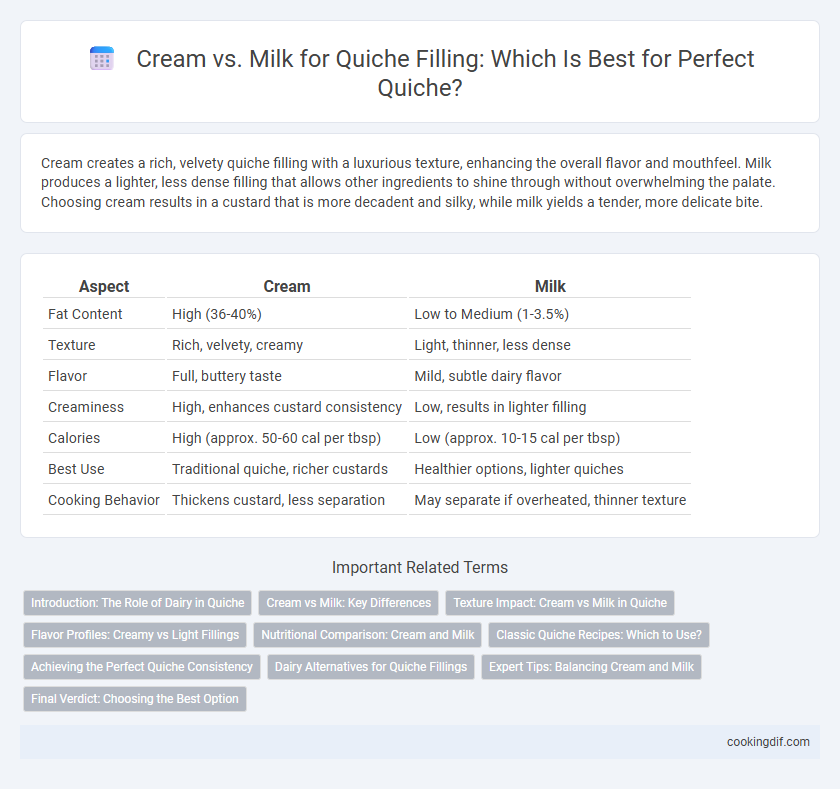Cream creates a rich, velvety quiche filling with a luxurious texture, enhancing the overall flavor and mouthfeel. Milk produces a lighter, less dense filling that allows other ingredients to shine through without overwhelming the palate. Choosing cream results in a custard that is more decadent and silky, while milk yields a tender, more delicate bite.
Table of Comparison
| Aspect | Cream | Milk |
|---|---|---|
| Fat Content | High (36-40%) | Low to Medium (1-3.5%) |
| Texture | Rich, velvety, creamy | Light, thinner, less dense |
| Flavor | Full, buttery taste | Mild, subtle dairy flavor |
| Creaminess | High, enhances custard consistency | Low, results in lighter filling |
| Calories | High (approx. 50-60 cal per tbsp) | Low (approx. 10-15 cal per tbsp) |
| Best Use | Traditional quiche, richer custards | Healthier options, lighter quiches |
| Cooking Behavior | Thickens custard, less separation | May separate if overheated, thinner texture |
Introduction: The Role of Dairy in Quiche
Cream creates a rich, velvety quiche filling by adding higher fat content, resulting in a custard that is smooth and tender. Milk offers a lighter texture with reduced fat, producing a more delicate and less dense quiche custard. Choosing between cream and milk impacts the quiche's mouthfeel, richness, and overall flavor balance.
Cream vs Milk: Key Differences
Cream provides a richer, silkier texture and higher fat content in quiche filling, resulting in a creamier mouthfeel and more luxurious taste. Milk, being thinner with lower fat, creates a lighter, less dense custard, which may yield a slightly firmer quiche. Choosing between cream and milk directly affects the quiche's consistency, richness, and overall flavor intensity.
Texture Impact: Cream vs Milk in Quiche
Using cream in quiche filling results in a richer, silkier texture due to its higher fat content, which creates a custard that is smooth and luxurious. Milk, with lower fat levels, produces a lighter, more delicate filling that tends to be slightly less creamy but still tender and moist. Choosing cream enhances the quiche's velvety mouthfeel, while milk yields a firmer, more delicate consistency.
Flavor Profiles: Creamy vs Light Fillings
Using cream in quiche filling results in a rich, velvety texture with intense, buttery flavor that enhances savory ingredients like cheese and bacon. Milk creates a lighter, more delicate custard, allowing subtle flavors such as spinach or herbs to shine without overpowering the dish. Choosing cream delivers a decadent mouthfeel, while milk offers a balanced, tender filling suited for looser, less dense quiches.
Nutritional Comparison: Cream and Milk
Cream contains higher fat content and calories compared to milk, making quiche fillings richer and more indulgent when using cream. Milk offers lower fat and fewer calories, providing a lighter alternative while still contributing to a smooth texture in quiche fillings. Choosing between cream and milk affects the quiche's nutritional profile, influencing both the richness and caloric density of the dish.
Classic Quiche Recipes: Which to Use?
Classic quiche recipes often call for heavy cream to achieve a rich, velvety texture and a luxurious mouthfeel, as the higher fat content provides a more custard-like filling. Milk, while lighter and lower in fat, results in a less creamy consistency and is better suited for a lighter quiche or those seeking a less rich flavor profile. Combining cream and milk can balance the richness and lightness, offering a custard that is tender yet not overly dense.
Achieving the Perfect Quiche Consistency
Using cream in quiche filling results in a richer, silkier texture with a firmer custard, while milk produces a lighter and more delicate consistency. A combination of heavy cream and whole milk balances richness and tenderness, ensuring the quiche sets properly without being overly dense or watery. For achieving the perfect quiche consistency, aim for a ratio of two parts cream to one part milk to maintain a smooth, luscious filling with optimal firmness.
Dairy Alternatives for Quiche Fillings
Dairy alternatives like coconut milk, almond milk, or cashew cream provide creamy textures and subtle flavors ideal for quiche fillings while catering to lactose intolerance and vegan diets. Silken tofu and oat milk also serve as excellent substitutes, offering richness without compromising the quiche's custard-like consistency. Choosing plant-based creams can enhance nutritional profiles, reduce saturated fat content, and accommodate diverse dietary needs in quiche recipes.
Expert Tips: Balancing Cream and Milk
Using a balanced ratio of cream to milk in quiche filling ensures a rich yet light texture, with experts often recommending a 2:1 ratio of cream to milk for optimal custard consistency. Heavy cream provides a luscious, smooth mouthfeel and helps the filling set firmly, while milk lightens the mixture, preventing it from becoming overly dense or greasy. For best results, use whole milk paired with at least 30% fat cream to achieve a perfectly tender and flavorful quiche filling.
Final Verdict: Choosing the Best Option
Cream delivers a richer, silkier texture for quiche filling, enhancing mouthfeel and flavor depth. Milk provides a lighter, healthier alternative that results in a tender but less decadent custard. The best option depends on whether richness or a lighter profile is preferred in the final quiche.
Cream vs milk for quiche filling Infographic

 cookingdif.com
cookingdif.com